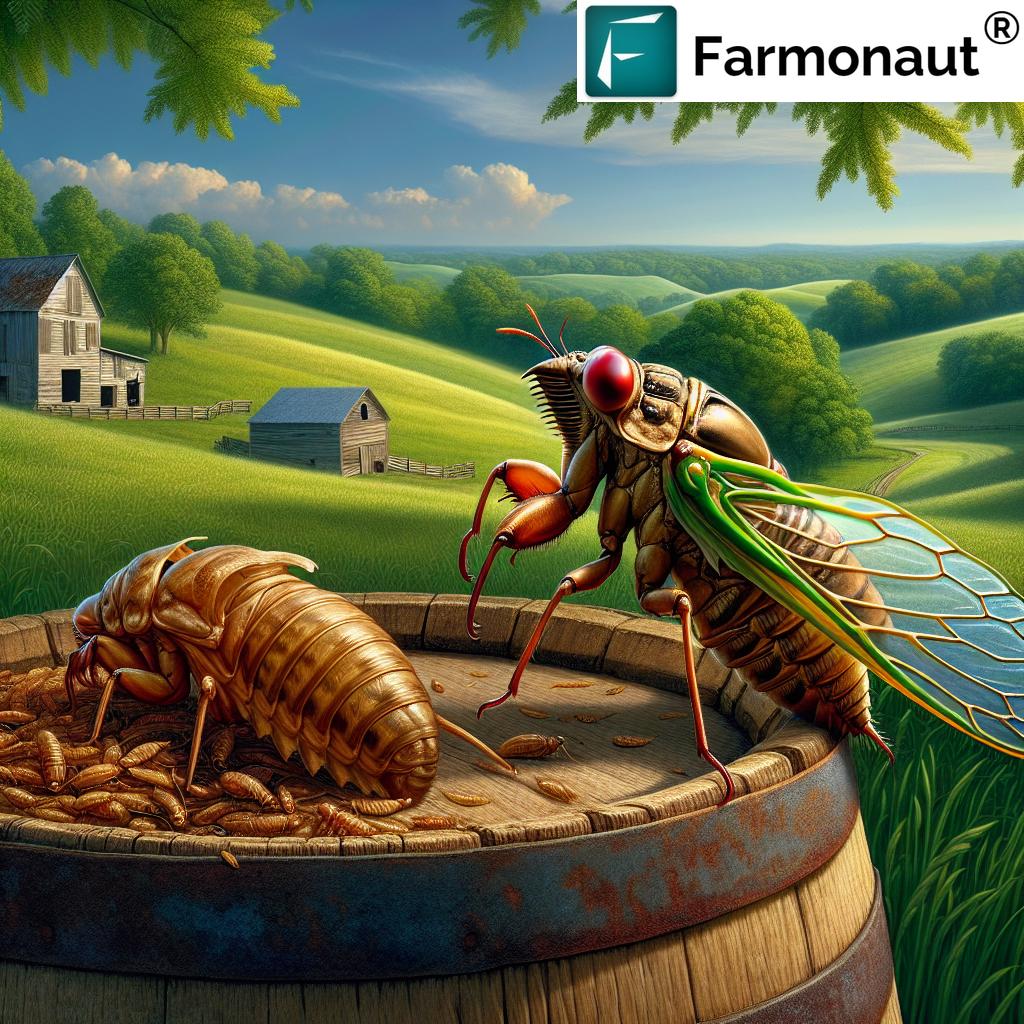Brood 14 Cicadas: Kentucky’s 17-Year Phenomenon Set to Emerge in Spring 2025
“Brood 14 cicadas emerge every 17 years, with the next Kentucky appearance scheduled for spring 2025.”
As we approach the spring of 2025, Kentucky is preparing for a remarkable natural spectacle that occurs only once every 17 years. The emergence of Brood 14 periodical cicadas, affectionately dubbed the “Bourbon Brood” by entomologists at the University of Kentucky Martin-Gatton College of Agriculture, Food and Environment, is set to transform the landscape and soundscape of the Bluegrass State. This fascinating phenomenon will make Kentucky the epicenter of one of nature’s most intriguing cyclical events, drawing the attention of scientists, nature enthusiasts, and curious onlookers alike.
In this comprehensive exploration of the Brood 14 cicada emergence, we’ll delve into the science behind these time-keeping insects, their impact on Kentucky’s environment and agriculture, and how residents can prepare for and appreciate this rare occurrence. From the rolling hills of Central Kentucky to the Appalachian regions of Eastern Kentucky, we’ll uncover the significance of this event and why it’s capturing the imagination of people across the state and beyond.
Understanding Periodical Cicadas: Nature’s Time-Keepers
Periodical cicadas are a marvel of the natural world, known for their precisely timed emergences that occur in 13 or 17-year cycles. The Brood 14 cicadas, set to appear in Kentucky in 2025, belong to the 17-year variety. These insects spend the vast majority of their lives underground as nymphs, feeding on tree root fluids before emerging en masse for a brief but spectacular adult phase.
- Life Cycle: 17 years underground, followed by 4-6 weeks above ground
- Distinctive Features: Red eyes, black bodies, and transparent wings
- Purpose of Emergence: Mating and egg-laying
- Sound Production: Males produce loud, distinctive calls to attract females
The synchronous emergence of billions of cicadas is a strategy that has evolved over millions of years. By appearing in such overwhelming numbers, cicadas ensure their survival as a species, as predators become satiated, allowing many cicadas to successfully reproduce.
The “Bourbon Brood”: Kentucky’s Unique Cicada Population
The moniker “Bourbon Brood” given to Kentucky’s Brood 14 cicadas by the University of Kentucky’s entomologists is more than just a catchy name. It reflects the deep connection between these insects and the state’s cultural and natural heritage. Just as Kentucky bourbon is renowned for its quality and the time-honored processes used in its creation, these cicadas are a testament to the precision and patience of nature.
“The “Bourbon Brood” cicadas will primarily emerge across Central and Eastern Kentucky, covering thousands of square miles.”
While periodical cicadas have made appearances in Western Kentucky counties in recent years, the 2025 emergence will be particularly significant for Central and Eastern Kentucky. This geographic focus makes Lexington and its surrounding areas the epicenter of the cicada phenomenon, offering researchers and citizens alike an unparalleled opportunity to observe and study these fascinating creatures.

The Environmental Impact of Cicada Emergence
The emergence of Brood 14 cicadas in Kentucky will have far-reaching effects on the local ecosystem. While their presence may seem disruptive at first, these insects play a crucial role in the environmental balance of the regions they inhabit.
- Soil Aeration: As cicadas emerge from the ground, they create numerous small holes that help aerate the soil, benefiting plant root systems.
- Nutrient Cycling: The mass die-off of cicadas after their brief adult phase provides a significant nutrient boost to the soil, acting as a natural fertilizer.
- Food Source: Many wildlife species, including birds, small mammals, and even fish, benefit from the abundant food source provided by cicadas.
- Tree Pruning: While cicadas can cause some damage to young trees through egg-laying, this natural pruning can actually stimulate growth in mature trees.
For farmers and gardeners concerned about the impact of cicadas on their crops and plants, tools like Farmonaut’s crop health monitoring system can be invaluable. This advanced technology uses satellite imagery to track vegetation health, helping agriculturists make informed decisions about pest management and resource allocation during the cicada emergence.
Preparing for the Cicada Emergence
As Kentucky gears up for the arrival of the Bourbon Brood, there are several steps that residents, farmers, and businesses can take to prepare for and make the most of this unique event:
- Protect Young Trees: Cover newly planted trees with fine netting to prevent damage from cicada egg-laying.
- Plan Outdoor Activities: Be aware that the cicada emergence may affect outdoor events due to the insects’ loud calls.
- Educate and Engage: Use this opportunity to learn about biodiversity and natural cycles with family and community members.
- Prepare for Increased Wildlife Activity: Expect to see more birds and small animals drawn to the abundant food source.
- Monitor Crop Health: Farmers can utilize Farmonaut’s AI-powered advisory system to receive personalized insights on managing their crops during this period.
The Science Behind the Cycle: Why 17 Years?
The 17-year lifecycle of Brood 14 cicadas is a subject of fascination for entomologists and evolutionary biologists. This long underground period is believed to be an evolutionary strategy that helps cicadas avoid synchronizing with the lifecycles of their predators. The prime number 17 is particularly significant, as it reduces the chances of predators adapting to the cicadas’ emergence pattern.
During their time underground, cicada nymphs go through five developmental stages, or instars, slowly growing and molting as they feed on tree root fluids. The final emergence is triggered by soil temperature, typically when it reaches about 64°F (18°C) at a depth of 8 inches (20 cm).
The Cultural Significance of Cicadas in Kentucky
The emergence of Brood 14 cicadas is not just a biological event; it’s a cultural phenomenon that has woven itself into the fabric of Kentucky’s heritage. For many Kentuckians, the cicada emergence marks the passage of time and serves as a living reminder of the state’s natural rhythms.
- Folklore and Traditions: Many local traditions and stories have developed around cicada emergences.
- Culinary Curiosities: Some adventurous eaters even incorporate cicadas into recipes, considering them a rare delicacy.
- Art and Music: The distinctive sound and appearance of cicadas have inspired local artists and musicians.
- Community Events: Many communities organize cicada-themed festivals and educational events during emergence years.

Cicadas and Kentucky’s Agriculture
While the emergence of Brood 14 cicadas is primarily a natural wonder, it does have implications for Kentucky’s agricultural sector. Farmers and orchard owners, in particular, need to be prepared for the potential impact on their crops and trees.
For those in the agricultural industry, staying informed about the cicada emergence and its effects is crucial. Farmonaut’s satellite-based farm management solutions can provide real-time data on crop health and soil conditions, helping farmers make informed decisions during this unique period.
The Role of Technology in Studying Cicada Emergence
Modern technology is playing an increasingly important role in the study and management of cicada emergences. From satellite imagery to AI-powered prediction models, these tools are helping scientists and agriculturists better understand and prepare for these cyclical events.
Farmonaut’s advanced agricultural technologies, while not specifically designed for cicada monitoring, offer valuable tools that can be applied to this unique situation:
- Satellite Imagery: High-resolution satellite images can help track large-scale vegetation changes that may be influenced by cicada activity.
- AI Advisory Systems: Predictive models can help farmers anticipate and mitigate potential impacts on their crops.
- Resource Management Tools: Efficient allocation of resources during the cicada emergence period can be crucial for maintaining crop health.
For more information on how these technologies can be applied to various agricultural challenges, including unusual events like cicada emergences, visit Farmonaut’s web application.
Citizen Science Opportunities
The emergence of Brood 14 cicadas presents a unique opportunity for citizen science initiatives in Kentucky. Researchers from universities and environmental organizations are encouraging the public to participate in various cicada-related projects:
- Mapping Emergence Sites: Using mobile apps to record cicada sightings and contribute to distribution maps.
- Phenology Studies: Observing and recording the timing of cicada life cycle events.
- Population Density Surveys: Helping scientists estimate the number of cicadas in different areas.
- Environmental Impact Assessments: Documenting the effects of cicadas on local flora and fauna.
These citizen science projects not only contribute valuable data to scientific research but also help raise public awareness about biodiversity and ecological processes.
Brood 14 Cicada Emergence Timeline and Impact
| Year | Cicada Stage | Environmental Impact |
|---|---|---|
| 2008 | Previous Emergence | Adult cicadas emerged, mated, and laid eggs |
| 2009-2024 | Underground Nymph Development | Gradual soil aeration, minor impact on tree root systems |
| Spring 2025 | Mass Emergence | Significant soil aeration, potential stress on young trees, increased biodiversity activity |
| Summer 2025 | Adult Stage and Die-off | Nutrient boost to soil, food source for wildlife, natural pruning of trees |
| Fall 2025 | Egg Hatching and Nymph Burrowing | Minor damage to small branches, beginning of new underground cycle |
The Future of Cicada Research in Kentucky
As we look beyond the 2025 emergence of Brood 14 cicadas, researchers in Kentucky are already planning for future studies and conservation efforts. The data collected during this emergence will be invaluable for understanding long-term ecological trends and the potential impacts of climate change on cicada populations.
Some areas of focus for future research include:
- Climate Change Effects: Studying how changing temperatures and weather patterns might affect cicada emergence timing and distribution.
- Genetic Diversity: Analyzing the genetic makeup of Brood 14 cicadas to understand their evolution and adaptability.
- Ecosystem Interactions: Investigating the long-term effects of cicada emergences on forest health and biodiversity.
- Urban Impact: Examining how urbanization affects cicada populations and their ability to complete their life cycles.
For those interested in supporting or participating in these research efforts, keep an eye on announcements from Kentucky’s universities and environmental organizations in the lead-up to the 2025 emergence.
Preparing Your Farm or Garden for Cicadas
For farmers and gardeners in Kentucky, the emergence of Brood 14 cicadas requires some special preparations. While cicadas don’t typically cause long-term damage to established plants, they can pose a risk to young trees and some crops. Here are some strategies to protect your plants:
- Delay New Plantings: If possible, wait until after the cicada emergence to plant new trees or shrubs.
- Use Protective Netting: Cover young trees with fine mesh netting to prevent cicadas from laying eggs in branches.
- Focus on Plant Health: Healthy plants are better able to withstand any stress caused by cicadas. Use Farmonaut’s crop health monitoring tools to ensure your plants are in optimal condition.
- Natural Pest Control: Encourage natural predators of cicadas, such as birds, by creating wildlife-friendly spaces in your garden or farm.
- Post-Emergence Care: After the cicadas have gone, inspect your plants for any damage and provide extra care if needed.
Remember, while cicadas may cause some short-term inconvenience, their overall impact on healthy, established plants is usually minimal. In fact, many farmers report increased crop yields in the years following a cicada emergence, likely due to the natural soil fertilization provided by the decomposing cicadas.
Cicadas and Sustainable Agriculture
The emergence of Brood 14 cicadas offers an opportunity to reflect on the principles of sustainable agriculture and how natural cycles can inform our farming practices. Here are some ways in which the cicada phenomenon aligns with sustainable farming:
- Natural Soil Enhancement: The decomposition of cicadas provides a natural, organic fertilizer boost to the soil.
- Biodiversity Support: Cicadas serve as a food source for various wildlife, contributing to overall ecosystem health.
- Pest Management Lessons: The cicadas’ strategy of predator satiation through mass emergence can inspire alternative approaches to pest management.
- Long-term Ecological Thinking: The 17-year cycle of cicadas encourages farmers to consider long-term ecological processes in their planning.
For farmers interested in leveraging these natural processes and adopting more sustainable practices, Farmonaut’s carbon footprinting tools can help track and reduce environmental impact. By understanding your farm’s carbon footprint, you can make informed decisions that align with both ecological principles and productive agriculture.
Economic Implications of the Cicada Emergence
While the emergence of Brood 14 cicadas is primarily an ecological event, it does have some economic implications for Kentucky:
- Tourism Boost: The unique phenomenon can attract nature enthusiasts and researchers, potentially increasing tourism in affected areas.
- Agricultural Considerations: Farmers may need to adjust their planting and harvesting schedules, particularly for young orchards or vineyards.
- Research Funding: The event may attract additional research funding to Kentucky’s universities and scientific institutions.
- Local Business Opportunities: Enterprising businesses may find ways to capitalize on the cicada emergence through special events or products.
For agribusinesses looking to optimize their operations during this unique period, Farmonaut’s fleet management solutions can help streamline logistics and resource allocation, ensuring efficient farm operations even during unusual natural events.
Cicadas in Kentucky’s Ecosystem: A Broader Perspective
The emergence of Brood 14 cicadas is not just an isolated event but a crucial part of Kentucky’s broader ecosystem. These insects play a vital role in the state’s ecological balance:
- Forest Rejuvenation: Cicada egg-laying can lead to natural pruning, stimulating new growth in trees.
- Soil Health: The tunneling activity of emerging cicadas aerates the soil, benefiting plant root systems.
- Food Web Support: Cicadas provide a abundant food source for various wildlife, from birds to mammals.
- Nutrient Cycling: The mass die-off of cicadas after emergence returns significant nutrients to the ecosystem.
Understanding these ecological interactions is crucial for sustainable land management. For those involved in large-scale agricultural or forestry operations, Farmonaut’s large-scale farm management tools can help integrate ecological considerations into your operational strategies, ensuring that your practices work in harmony with natural cycles like the cicada emergence.
FAQs About Brood 14 Cicadas in Kentucky
Q: Are cicadas harmful to humans or pets?
A: No, cicadas are not harmful to humans or pets. They don’t bite or sting and are not known to carry diseases.
Q: How long will the cicada emergence last?
A: The emergence typically lasts about 4-6 weeks from when the first cicadas appear until the last ones die off.
Q: Will cicadas damage my garden?
A: While cicadas can cause some damage to young trees through egg-laying, established plants and gardens generally aren’t significantly affected.
Q: How can I contribute to cicada research?
A: You can participate in citizen science projects by reporting cicada sightings, collecting data on emergence patterns, or volunteering with local research initiatives.
Q: What should I do if I find cicadas on my property?
A: In most cases, it’s best to leave cicadas alone. They play an important role in the ecosystem and will naturally complete their life cycle.
Conclusion: Embracing Kentucky’s Natural Wonder
As we approach the spring of 2025, Kentucky stands on the brink of witnessing one of nature’s most fascinating spectacles. The emergence of Brood 14 cicadas, our very own “Bourbon Brood,” is not just a biological event but a celebration of the state’s natural heritage and ecological richness. From the rolling hills of Central Kentucky to the Appalachian regions of the east, this phenomenon will touch communities across the state, offering unique opportunities for learning, research, and appreciation of our natural world.
For farmers, gardeners, and land managers, this event presents both challenges and opportunities. By leveraging modern agricultural technologies like those offered by Farmonaut, we can navigate this unique period while gaining valuable insights into our ecosystems and agricultural practices. Whether you’re a seasoned farmer, a curious citizen scientist, or simply someone who marvels at the wonders of nature, the Brood 14 cicada emergence is an event that will leave a lasting impression on all who witness it.
As we prepare for this remarkable natural phenomenon, let’s embrace the opportunity to learn, engage, and appreciate the intricate rhythms of our natural world. The cicadas’ 17-year journey reminds us of the patience and precision inherent in nature, echoing the time-honored traditions of Kentucky’s own bourbon-making heritage. In 2025, as the air fills with the distinctive chorus of cicadas, we’ll be witnessing not just an emergence of insects, but a reaffirmation of Kentucky’s enduring connection to the natural world.
Earn With Farmonaut: Affiliate Program
Earn 20% recurring commission with Farmonaut’s affiliate program by sharing your promo code and helping farmers save 10%. Onboard 10 Elite farmers monthly to earn a minimum of $148,000 annually—start now and grow your income!




















